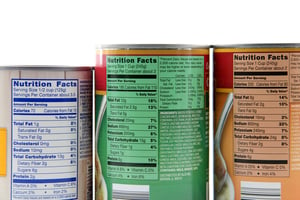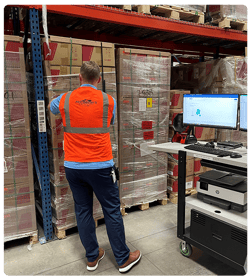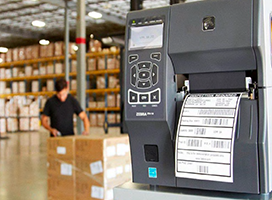
Labeling mistakes in production and fulfillment is a huge issue that can cost an organization significant time and money. Whether your business approaches labeling manually or using automated methods, there could be weaknesses in the processes that have ripple effects throughout the supply chain. Here are some of the top challenges businesses face with labeling and how they can address them using some simple solutions.
Why Proper Labeling is Important
Proper labeling of products is essential for many reasons that impact a business’s success.
Consumer Safety
Labels give consumers the information they need to make informed decisions about proper product usage, storage, allergens, expiration dates, and more. Without this information, consumers may be unable to use the products safely.
Regulatory Compliance
 Proper labeling is critical for businesses to comply with legal requirements. Various regulatory bodies, such as the Food and Drug Administration (FDA), create and enforce standards for product labeling.
Proper labeling is critical for businesses to comply with legal requirements. Various regulatory bodies, such as the Food and Drug Administration (FDA), create and enforce standards for product labeling.
Branding
Labeling establishes an organization’s brand identity, which creates an impression on consumers. For example, customers will recognize your brand based on its labeling and even know where to look to find certain information.
Supply Chain Efficiency
Labels are vital to keep products moving through the supply chain efficiently. They allow supply chain partners to know what inventory they have on hand and see what is moving through the system using various technology solutions.
Customer Experience
An attractive and informative label can provide a positive customer experience, while a label that misrepresents what’s in the package can do the opposite.
Common Labeling Challenges That Lead to Mistakes
If labeling is so essential for businesses, it’s understandable that problems in this area can be frustrating. Here are some common labeling challenges that organizations struggle to solve.
Evolving Labeling Standards and Regulations
One of the biggest labeling challenges organizations face is related to compliance. Various governing and regulatory agencies create rules and standards for product labels, as do industry associations. These standards can be different depending on the jurisdiction, and they can also change over time. Large retailers like Amazon and Walmart require that sellers follow certain labeling rules before products can be sold in stores or online.
Labeling and Barcode Issues
Labeling errors can have far-reaching impacts, such as creating supply chain inefficiencies and causing product recalls. Some common labeling and barcode errors include:
- Incorrect data — Errors with dates, symbols, ingredients, or other information can lead to recalls.
- Color issues — Low contrast can affect barcode readability.
- Misplaced barcodes — Barcodes may be unreadable if they don’t have proper borders or are placed on a curve.
- Disrupted barcodes — Labels that are torn, peeling, or covered may be unreadable.
- Poor print quality — If barcodes are blotchy or the lines aren’t spaced properly, they may not be scannable.
Inconsistent Labeling Processes
 Labeling in manufacturing or fulfillment can be a complex process that must consider things like regulations, supply chain partners, and end users. When the process is inconsistent or inefficient, it will be more costly, time-consuming, and error-prone than it should be. These inconsistencies can impact the customer experience and your business’s overall results.
Labeling in manufacturing or fulfillment can be a complex process that must consider things like regulations, supply chain partners, and end users. When the process is inconsistent or inefficient, it will be more costly, time-consuming, and error-prone than it should be. These inconsistencies can impact the customer experience and your business’s overall results.
Industry-Specific Problems
Labeling requirements and nuances can vary depending on the particular industry and product. For example, there are specific labeling requirements for food and different ones for pharmaceuticals. A business producing or storing products for any industry must be properly educated on these requirements and have systems in place to create satisfactory audit trails.
Customer Requirements
Many businesses fail to consider the customer’s wants and needs when it comes to product labels. For example, more and more consumers want to support organizations that are sustainable and transparent about the ingredients used in their products. A proper labeling strategy is necessary to fulfill these needs.
Solutions for Efficient Labeling in Production and Fulfillment
Here are some ways businesses can tackle label mistakes to boost overall performance and improve business results.
Avoid Advance and Batch Label Printing
 One way to prevent mislabeling items is to stop printing labels in advance. It’s estimated that production workers make 1 mistake for every 300 touches--thanks in large part to manual processes for things like labeling.
One way to prevent mislabeling items is to stop printing labels in advance. It’s estimated that production workers make 1 mistake for every 300 touches--thanks in large part to manual processes for things like labeling.
Instead of batch printing, labels should be printed as close to the time of application as possible. A more streamlined process for label printing is to use mobile power carts, which can eliminate these costly mistakes. In fact, this solution can increase labeling accuracy by as much as 99.8%.
Employ Data Validation Processes
Data validation is a critical process that can prevent common mislabeling errors. For example, data validation can force users to enter data in a specific date format or refuse to take a product number that is more or less than a certain number of characters. This can eliminate obvious anomalies to clear up common labeling errors.
Automate Quality Management
Mislabeling products is a costly issue for businesses. While quality control is essential, that function can also have errors if it is run by humans. One recent survey found that 67% of manufacturers still rely on manual inspections.
One way to improve this process is to automate quality management. Automated marking and coding can help reduce human errors and minimize the cost of reworking them.
Enable Data Traceability
One of the biggest lessons learned during the pandemic was that supply chain partners need better information. Specifically, a lack of traceability throughout the supply chain leads to uncertainty, further delays, higher costs, and an overall lack of trust in the system.
By using solutions like RFID tags, businesses can enable real-time traceability. This means a manufacturer or warehouse will know exactly what is on their shelves at any given time and what is on the way from supply chain partners.
When organizations rely on dated or overly complex labeling systems, it can lead to inefficiencies that result in unnecessary errors. These mistakes are often linked to product recalls, regulatory compliance issues, and a poor customer experience. By switching to mobile power carts for labeling, businesses can eliminate many of these costly mistakes.












